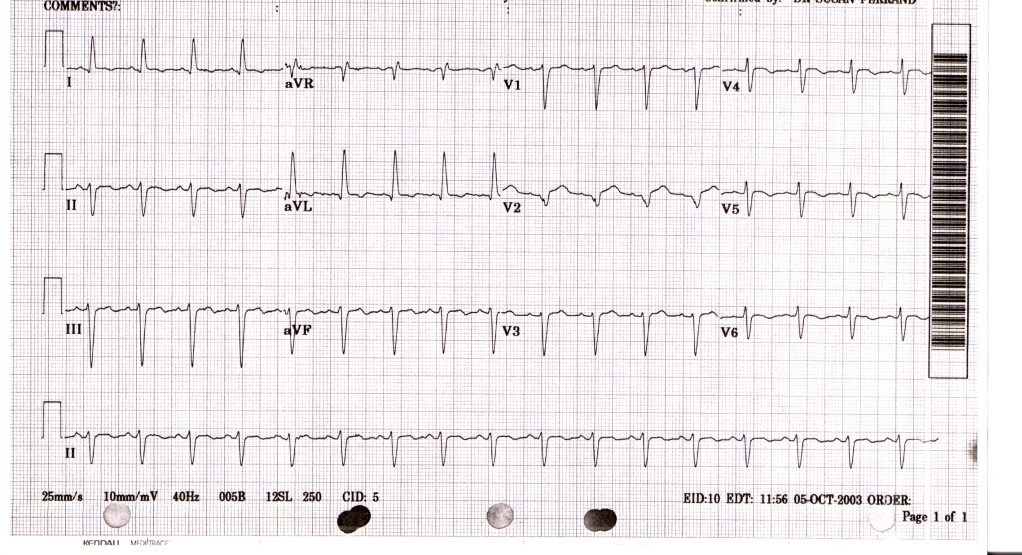Stress cardiomyopathy electrocardiogram
|
Stress cardiomyopathy Microchapters |
|
Diagnosis |
|---|
|
Treatment |
|
Unstable angina/non ST elevation myocardial infarction in Stress (Takotsubo) Cardiomyopathy |
|
Case Studies |
|
Stress cardiomyopathy electrocardiogram On the Web |
|
American Roentgen Ray Society Images of Stress cardiomyopathy electrocardiogram |
|
Risk calculators and risk factors for Stress cardiomyopathy electrocardiogram |
Editor-In-Chief: C. Michael Gibson, M.S., M.D. [1]; Associate Editor(s)-in-Chief: Dima Nimri, M.D. [2]
Overview
ECG findings in stress cardiomyopathy are similar to those seen in anterior MI. The most common findings include ST elevation in the precordial leads, T wave inversion and the formation of a Q wave.
Electrocardiogram
The ECG findings are often confused with those of an acute anterior wall myocardial infarction.[1][2] Findings on ECG include:[2][3][4][5][6][7][8]
- ST elevation in the precordial leads
- T wave inversion
- Q wave formation
- QT prolongation
- New-onset bundle branch block (BBB)
- Rarely, malignant ventricular arrhythmias may be seen

References
- ↑ Bybee KA, Motiei A, Syed IS, Kara T, Prasad A, Lennon RJ, Murphy JG, Hammill SC, Rihal CS, Wright RS (2006). "Electrocardiography cannot reliably differentiate transient left ventricular apical ballooning syndrome from anterior ST-segment elevation myocardial infarction". J Electrocardiol. PMID 17067626.
- ↑ 2.0 2.1 Akashi YJ, Goldstein DS, Barbaro G, Ueyama T (2008). "Takotsubo cardiomyopathy: a new form of acute, reversible heart failure". Circulation. 118 (25): 2754–62. doi:10.1161/CIRCULATIONAHA.108.767012. PMC 4893309. PMID 19106400.
- ↑ Brenner ZR, Powers J (2008). "Takotsubo cardiomyopathy". Heart Lung. 37 (1): 1–7. doi:10.1016/j.hrtlng.2006.12.003. PMID 18206521.
- ↑ Prasad A, Lerman A, Rihal CS (2008). "Apical ballooning syndrome (Tako-Tsubo or stress cardiomyopathy): a mimic of acute myocardial infarction". Am. Heart J. 155 (3): 408–17. doi:10.1016/j.ahj.2007.11.008. PMID 18294473.
- ↑ Tsai TT, Nallamothu BK, Prasad A, Saint S, Bates ER (2009). "Clinical problem-solving. A change of heart". N. Engl. J. Med. 361 (10): 1010–6. doi:10.1056/NEJMcps0903023. PMID 19726776.
- ↑ Bybee KA, Prasad A, Barsness GW, Lerman A, Jaffe AS, Murphy JG, Wright RS, Rihal CS (2004). "Clinical characteristics and thrombolysis in myocardial infarction frame counts in women with transient left ventricular apical ballooning syndrome". Am. J. Cardiol. 94 (3): 343–6. doi:10.1016/j.amjcard.2004.04.030. PMID 15276100.
- ↑ Templin C, Ghadri JR, Diekmann J, Napp LC, Bataiosu DR, Jaguszewski M, Cammann VL, Sarcon A, Geyer V, Neumann CA, Seifert B, Hellermann J, Schwyzer M, Eisenhardt K, Jenewein J, Franke J, Katus HA, Burgdorf C, Schunkert H, Moeller C, Thiele H, Bauersachs J, Tschöpe C, Schultheiss HP, Laney CA, Rajan L, Michels G, Pfister R, Ukena C, Böhm M, Erbel R, Cuneo A, Kuck KH, Jacobshagen C, Hasenfuss G, Karakas M, Koenig W, Rottbauer W, Said SM, Braun-Dullaeus RC, Cuculi F, Banning A, Fischer TA, Vasankari T, Airaksinen KE, Fijalkowski M, Rynkiewicz A, Pawlak M, Opolski G, Dworakowski R, MacCarthy P, Kaiser C, Osswald S, Galiuto L, Crea F, Dichtl W, Franz WM, Empen K, Felix SB, Delmas C, Lairez O, Erne P, Bax JJ, Ford I, Ruschitzka F, Prasad A, Lüscher TF (2015). "Clinical Features and Outcomes of Takotsubo (Stress) Cardiomyopathy". N. Engl. J. Med. 373 (10): 929–38. doi:10.1056/NEJMoa1406761. PMID 26332547.
- ↑ Efferth T, Banerjee M, Paul NW (2016). "Broken heart, tako-tsubo or stress cardiomyopathy? Metaphors, meanings and their medical impact". Int. J. Cardiol. doi:10.1016/j.ijcard.2016.12.129. PMID 28041712.